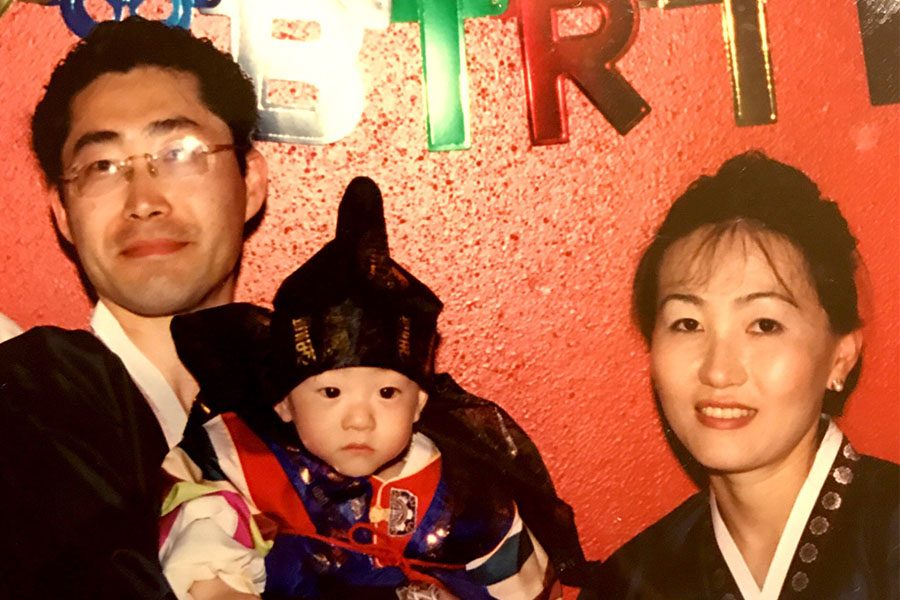Bryan at age one pictured with his father Sokho and mother Young Ryu.
Bryan Kim
April 25, 2018
Although there are just under 900 households in Frisco who primarily speak and identify with the Korean culture, freshman Bryan Kim believes being Korean in Frisco gives him the ability to connect with others of the same heritage who also live in his community.
“Being in Frisco helps me meet others with similar ethnic backgrounds as me such as at church where there are some of my best friends,” Kim said.
In addition to connecting with others who have a similar heritage in weekly activities, there are various places in the Dallas-Fort Worth area that allow Kim to further interact with his culture.
“There are many places in DFW to get Korean food and ingredients, such as the H Mart, a Korean marketplace with two locations, one in Plano and one in Carrollton,” Kim said. “Another would be in Koreatown [near Dallas] with streets filled with Korean restaurants.”
Along with Korean food being implemented into the culture of DFW, K-pop music has become more and more popular in the United States in recent years.
“I feel like the more albums that Kpop groups are dropping, the growing popularity they receive,” Kim said. “K-pop has definitely become a lot bigger over the years and due to this popularity, I get several classmates coming to ask if I could teach them [Korean] or any other aspects of the culture associated with it.”
Even though Kim lives almost 7,000 miles away from most of his family, he still finds ways to communicate with his relatives in Seoul, South Korea.
“My close family is the only family living in the U.S.,” Kim said. “I’ve visited South Korea a few times, but not very often and instead usually contact them through video chatting or texting.”
Although Kim and his family live in the United States, they still practice elements of the Korean culture through certain holidays and home-cooked foods.
“We express our culture through eating Korean food on a weekly basis and participating in Korean traditions and holidays from time to time,” Kim said. “One example would be eating a stew called ‘meeyukgook’ on birthdays and calling relatives on Lunar New Year’s.”
Kim’s heritage can also be seen through the origin of his last name, as well as his mother’s maiden last name.
“My dad’s last name is Kim, the most common last name among the South Korean population,” Kim said. “My mom’s last name is Ryu, which derived from the last name ‘Yoo.’”
Along with having one of the most common Korean last names, Kim is fluent in Korean as well as English.
“I can read and write in Korean in order to communicate with others in Korea or those who speak it and also help my mom out with understanding some stuff,” Kim said. “There aren’t really any drawbacks except for me getting some words confused between English and Korean.”
For Kim, being Korean comes with not only knowing another language, but also hearing stereotypes about his culture.
“One [stereotype] would be that all Koreans eat dogs,” Kim said. “Never have I met another Korean who has eaten nor thought of eating a dog due to morals and just the fact of why would you eat that if there’s so much more to choose from.”
Not only does Kim and his family hear racial assumptions about their culture, his dad Sokho Kim has also experienced being treated differently in the workplace, even though it is unconstitutional via the Equal Employment Opportunity Commission.
“We are not supposed to be treated differently because of Equal Opportunity act at workplaces and academic institutions, however, occasionally we encounter such obstacles,” Sokho said. “We need to understand and educate ourselves over the benefit of diversity and recognize the difference as we might be doing the same thing to others.”
While Kim’s family may go through a few obstacles, Sokho believes that there are greater educational opportunities in the U.S. for his son compared to South Korea.
“We hoped that my child could get better opportunity at school with a more creative and open minded environment, which can lead to developed skills and identifying individual potential,” Sokho said. “We believe that this is the major difference between the education system in U.S. and Korea.”
